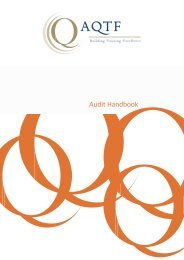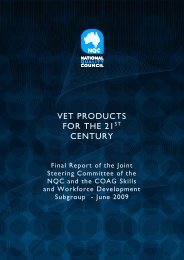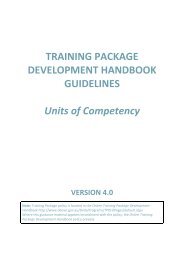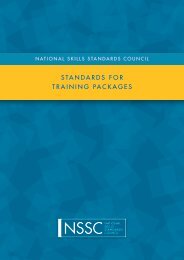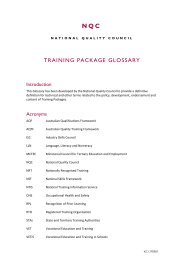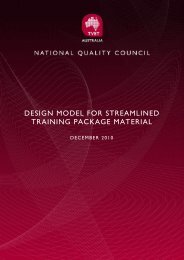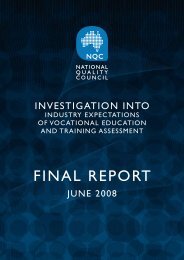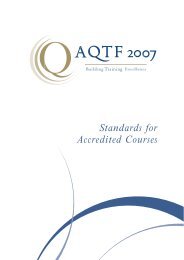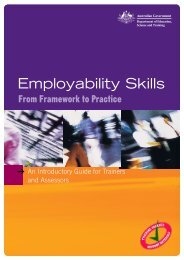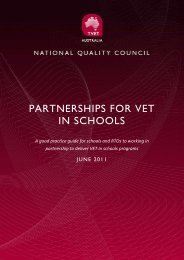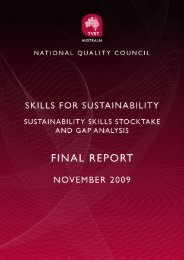Guide for Developing Assessment Tools - National Skills Standards ...
Guide for Developing Assessment Tools - National Skills Standards ...
Guide for Developing Assessment Tools - National Skills Standards ...
- No tags were found...
Create successful ePaper yourself
Turn your PDF publications into a flip-book with our unique Google optimized e-Paper software.
NQC | <strong>Guide</strong> <strong>for</strong> developing assessment toolsList of TablesTABLE 1: IDEAL CHARACTERISTICS OF AN ASSESSMENT TOOL .............................................................. 7TABLE 2: PORTFOLIO: EXEMPLAR ASSESSMENT TOOL FEATURES. ....................................................... 8TABLE 3: WORKPLACE OBSERVATION: EXEMPLAR ASSESSMENT TOOL FEATURES. .......................... 10 TABLE 4: PRODUCT BASED METHODS: EXEMPLAR ASSESSMENT TOOL FEATURES. .......................... 13 TABLE 5: INTERVIEW: EXEMPLAR ASSESSMENT TOOL FEATURES. ...................................................... 16 GUIDE FOR DEVELOPING ASSESSMENT TOOLS PAGE 3
NQC | <strong>Guide</strong> <strong>for</strong> developing assessment toolsTable 1: Ideal Characteristics of an <strong>Assessment</strong> ToolComponentThe contextCompetencyMappingThe in<strong>for</strong>mation tobe provided to thecandidateThe evidence to becollected from thecandidateDecision makingrulesRange andconditionsMaterials/resourcesrequiredAssessorinterventionReasonableadjustments (<strong>for</strong>enhancing fairnessand flexibility)Validity evidenceReliability evidenceRecordingrequirementsReportingrequirementsDescriptionThe target group and purpose of the tool should be described. This should include adescription of the background characteristics of the target group that may impact on thecandidate per<strong>for</strong>mance (e.g. literacy and numeracy requirements, workplaceexperience, age, gender etc).The components of the Unit(s) of Competency that the tool should cover should bedescribed. This could be as simple as a mapping exercise between the components ofthe task (e.g. each structured interview question) and components within a Unit orcluster of Units of Competency. The mapping will help to determine the sufficiency ofthe evidence to be collected. An example of how this can be undertaken has beenprovided in Template A.2 (refer to the Appendix).Outlines the task(s) to be provided to the candidate that will provide the opportunity <strong>for</strong>the candidate to demonstrate the competency. It should prompt them to say, do, writeor create something.Provides in<strong>for</strong>mation on the evidence to be produced by the candidate in response tothe task.The rules to be used to:Check evidence quality (i.e. the rules of evidence);Judge how well the candidate per<strong>for</strong>med according to the standard expected (i.e.the evidence criteria); andSynthesise evidence from multiple sources to make an overall judgement.Outlines any restriction or specific conditions <strong>for</strong> the assessment such as the location,time restrictions, assessor qualifications, currency of evidence (e.g. <strong>for</strong> portfolio basedassessments), amount of supervision required to per<strong>for</strong>m the task (i.e. which mayassist with determining the authenticity of evidence) etc.Describes access to materials, equipment etc that may be required to per<strong>for</strong>m the task.Defines the amount (if any) of support provided.This section should describe the guidelines <strong>for</strong> making reasonable adjustments to theway in which evidence of per<strong>for</strong>mance is gathered (e.g. in terms of the in<strong>for</strong>mation tobe provided to the candidate and the type of evidence to be collected from thecandidate) without altering the expected per<strong>for</strong>mance standards (as outlined in thedecision making rules).Evidence of validity (such as face, construct, predictive, concurrent, consequential andcontent) should be provided to support the use of the assessment evidence <strong>for</strong> thedefined purpose and target group of the tool.If using a per<strong>for</strong>mance based task that requires professional judgement of theassessor, evidence of reliability could include providing evidence of:The level of agreement between two different assessors who have assessed thesame evidence of per<strong>for</strong>mance <strong>for</strong> a particular candidate (i.e. inter-rater reliability);andThe level of agreement of the same assessor who has assessed the sameevidence of per<strong>for</strong>mance of the candidate, but at a different time (i.e. intra-raterreliability).If using objective test items (e.g. multiple choice tests) than other <strong>for</strong>ms of reliabilityshould be considered such as the internal consistency of a test (i.e. internal reliability)as well as the equivalence of two alternative assessment tasks (i.e. parallel <strong>for</strong>ms).The type of in<strong>for</strong>mation that needs to be recorded and how it is to be recorded andstored, including duration.For each key stakeholder, the reporting requirements should be specified and linked tothe purpose of the assessment.GUIDE FOR DEVELOPING ASSESSMENT TOOLS PAGE 7
NQC | <strong>Guide</strong> <strong>for</strong> developing assessment tools2.1 PORTFOLIONote a portfolio is defined here as a purposeful collection of samples of annotated andvalidated pieces of evidence (e.g. written documents, photographs, videos, audio tapes).Table 2: Portfolio: Exemplar <strong>Assessment</strong> Tool Features.Component Feature Generic ApplicationThe context The purpose and target The target group is XXX candidates undertaking the Certificate of XXX. Thisgroup should betool assists with assessing the candidate’s application of knowledge and skillsdescribedand will need to be assessed in conjunction with XXX (e.g. interview) toensure adequate coverage of the entire Unit of Competency.Competency Map key components of The assessment criteria used to evaluate the contents of the portfolio shouldMapping task to the Units(s) of be mapped directly against the Unit(s) of Competency. This will help toCompetency (content determine the sufficiency of the evidence to be collected and determinevalidity) – refer to whether any other aspects of the Unit(s) of competency need to be collectedTemplate A.2elsewhere.In<strong>for</strong>mation to Outline the task to be The tool should provide instructions to the candidate <strong>for</strong> how the portfoliocandidate provided to the should be put together. For example, the candidate may be instructed to:candidate that willSelect the pieces of evidence to be included;provide the opportunity Provide explanations of each piece of evidence;<strong>for</strong> the candidate toInclude samples of evidence only if they take on new meaning within thedemonstrate thecontext of other entries;competency. It should Include evidence of self-reflection;prompt them to say, do, Map each piece of evidence to the Unit(s) of Competency;write or createInclude evidence of growth or development; andsomething.Include a table of contents <strong>for</strong> ease of navigation.Evidence from Provides in<strong>for</strong>mation on The instructions <strong>for</strong> submitting the portfolio should be included here as well ascandidate the evidence to be a description of the evidence criteria that would be used to assess theproduced by theportfolio.candidate in response tothe task.Decision The rules to be used to: This section should outline the procedures <strong>for</strong> checking the appropriatenessmaking rules check evidence and trustworthiness of the evidence included within the portfolio such as the:quality (i.e. the rules Currency of evidence within the portfolio - is the evidence relativelyof evidence)recent).The rules <strong>for</strong> determining currency would need to be specifiedjudge how well the here (e.g. less than five years);candidate per<strong>for</strong>med Authenticity -is there evidence included within the portfolio that verifiesaccording to thethat the evidence is that of the candidate and/or if part of a teamstandard expected contribution, what aspects were specific to the candidate (e.g. testimonial(i.e. the evidencestatements from colleagues, opportunity to verify qualifications withcriteria); andissuing body etc);synthesise evidence Sufficiency - is there enough evidence to demonstrate to the assessorfrom multiplecompetence against the entire unit of competency, including the criticalsources to make an aspects of evidence described in the Evidence <strong>Guide</strong> (e.g. evidence ofoverall judgement consistency of per<strong>for</strong>mance across time and contexts);Content Validity – does the evidence match the unit of competency (e.g.relevance of evidence and justification by candidate <strong>for</strong> inclusion, as wellas annotations and reflections);Once the evidence within the portfolio has been determined to betrustworthy and appropriate, the evidence will need to be judged againstevidence criteria such as:Profile descriptions of varying levels of achievement (e.g.competent versus not yet competent per<strong>for</strong>mance (alsoreferred to as standard referenced frameworks1);Behaviourally Anchored Rating Scales (BARS)2 thatdescribe typical per<strong>for</strong>mance from low to high (alsoreferred to as analytical rubrics); andThe Unit of Competency presented in some <strong>for</strong>m of a checklist. The outcomes of the portfolio assessment should be recorded and signed and 1 Standard referenced frameworks requires the development and use of scoring rubrics that are expressed in the <strong>for</strong>m of ordered, transparent descriptionsof quality per<strong>for</strong>mance that are specific to the Unit of Competency, underpinned by a theory of learning and are hierarchical and sequential.2Behaviourally Anchored Rating Scales (BARS) are constructed by identifying examples of the types of activities or behaviour typically per<strong>for</strong>med byindividuals with varying levels of expertise. Each behaviour/activity is then ordered in terms of increasing proficiency and linked to a point on a rating scale,with typically no more than five points on the scale. Each behaviourally anchored rating scale can be treated as a separate item on the Observation Form inwhich each item requires the observer to select the statement that best describes the per<strong>for</strong>mance of the candidate’s application of skills and knowledge inthe workplace.GUIDE FOR DEVELOPING ASSESSMENT TOOLS PAGE 8
NQC | <strong>Guide</strong> <strong>for</strong> developing assessment toolsComponent Feature Generic Applicationdated by the assessor and the comment section should indicate where thereare any gaps or further evidence required.Range and Outlines any restriction It should be explained to candidates (preferably in written <strong>for</strong>mat prior to theconditions or specific conditions <strong>for</strong> preparation of the portfolio) that the portfolio should not be just an overallthe assessment such as collection of candidate’s work, past assessment outcomes, checklists and ofthe location, time the in<strong>for</strong>mation commonly kept in candidates’ cumulative folders. Therestrictions, assessor candidate should be instructed to include samples of work only if they take onqualifications etc. new meaning within the context of other entries. Consideration of evidenceacross time and varying contexts should be emphasised to the candidate.Candidate should also be instructed to only include recent evidence(preferable less than five years) although more dated evidence can be usedbut should be defended <strong>for</strong> inclusion. Such in<strong>for</strong>mation should be provided inwritten <strong>for</strong>mat to the candidate prior to preparing the portfolio.Materials/resou Describes access to Materials to be provided to the candidate to assist with preparing his/herrces required materials, equipment etc portfolio may include access to: photocopier, personal human resource filesthat may be required. etc., if required.Assessor Defines the amount (if Clarification of portfolio requirements permitted.intervention any) of supportprovided.Reasonable <strong>Guide</strong>lines <strong>for</strong> making An electronic and/or product based version of the portfolio may be preparedadjustments reasonable adjustments by the candidate. The portfolio may include videos, photographs etc.to the way in whichevidence of per<strong>for</strong>manceis gathered withoutaltering the expectedper<strong>for</strong>mance standardsValidity Evidence of validity to Evidence of the validity of the portfolio tool may include:support the use of the Detailed mapping of the evidence used to judged the portfolio with theassessment evidence Unit(s) of Competency (content validity);<strong>for</strong> the defined purpose Inclusion of documents produced within the workplace and/or has directand target group of the application to the workplace (face validity);tool.Evidence that the tool was panelled with subject matter experts (face andcontent validity);The tool clearly specifying the purpose of the tool, the target population,the evidence to be collected, decision making rules, reportingrequirements, as well as the boundaries and limitations of the tool(consequential validity); andEvidence of how the literacy and numeracy requirements of the unit(s) ofcompetency have been adhered to (construct validity).Reliability Evidence of the Evidence of the reliability of the portfolio tool may include:reliability of the toolDetailed scoring and/or evidence criteria <strong>for</strong> the content to be judgedshould be included.within the portfolio (inter-rater reliability); andRecording sheet to record judgements in a consistent and methodicalmanner (intra-rater reliability).Recording The type of in<strong>for</strong>mation The following in<strong>for</strong>mation should be recorded and maintained:requirements that needs to be The Portfolio tool (<strong>for</strong> validation and/or moderation purposes);recorded and how it is to Samples of candidate portfolios of varying levels of quality (<strong>for</strong>be recorded and stored, moderation purposes); andincluding duration.Summary Results of each candidate per<strong>for</strong>mance on the portfolio as wellas recommendations <strong>for</strong> future assessment and/or training etc inaccordance with the organisation’s record keeping policy.The outcomes of moderation and validation meetings should also be recordedin accordance with the organisation’s requirements. The overall assessmentresult should be recorded electronically on the organisation’s candidate recordkeeping management system.Reporting For each key Candidate: Overall decision and recommendations <strong>for</strong> any futurerequirements stakeholder, the training. Progress toward qualification and/or grades/competenciesreporting requirements achieved;should be specified and Trainer: Recommendations <strong>for</strong> future training requirements; andlinked to the purpose ofthe assessment.Workplace Supervisor: <strong>Assessment</strong> results and competencies achieved.GUIDE FOR DEVELOPING ASSESSMENT TOOLS PAGE 9
NQC | <strong>Guide</strong> <strong>for</strong> developing assessment toolsComponent Feature Generic applicationcompetence of the candidate would need to be documented(e.g. do all items have to be observed by the assessor?). The<strong>for</strong>m should also provide the opportunity <strong>for</strong> the observer torecord that s/he has not had the opportunity to observe thecandidate applying these skills and knowledge. Again,instructions on how to treat not observed items on the checklistwould need to be included within the tool. The <strong>for</strong>m should alsobe designed to record the number of instances and/or period ofobservation (this will help determine the level of sufficiency ofthe evidence to be collected), as well as the signature of theobserver; and the date of observation(s) (to authenticate theevidence and to determine the level of currency).Range and Outlines any restriction or Assessors need to provide the necessary materials to theconditions specific conditions <strong>for</strong> the candidate, as well as explain or clarify any concerns/questions.assessment such as the The period of observation should be communicated to thelocation, time restrictions, observer and candidate and this would need to be negotiatedassessor qualifications etc. and agreed to by workplace colleagues, to minimiseinterruptions to the everyday activities and functions of theworkplace environment.Materials/ Describes access to The tool should also specify the materials required to record theresources materials, equipment etc that candidate’s per<strong>for</strong>mance. For example:required may be required to per<strong>for</strong>m A copy of the Unit(s) of Competency;the task.The Observation Form;Pencil/paper; andVideo camera.In addition, any specific equipment required by the candidate toper<strong>for</strong>m the demonstration and/or simulation should bespecified.Assessor Defines the amount (if any) of In cases where observations are to be made by an internal staffintervention support provided member and are to be unannounced, the candidate needs to bewarned that s/he will be observed over a period of time <strong>for</strong>purposes of <strong>for</strong>mal assessment against the Unit(s) ofCompetency. If the observer is external to the workplace (e.g.teacher or trainer), s/he will need to ensure that the time anddate of the visit to the candidate’s workplace is confirmed andagreed to by the candidate and the workplace manager. Theexternal observer will need to in<strong>for</strong>m the candidate and his/herimmediate supervisor of his/her presence on the worksite assoon as possible. At all times, the external observer will need toavoid hindering the activities of the workplace.Reasonable <strong>Guide</strong>lines <strong>for</strong> making If the candidate does not have access to the workplace, thenadjustments reasonable adjustments to suitable examples of simulated activities may be used. Thisthe way in which evidence of section would outline any requirements and/or conditions <strong>for</strong>per<strong>for</strong>mance is gathered the simulated activity.without altering the expectedper<strong>for</strong>mance standardsValidity Evidence of validity should be Evidence of the validity of the observation tool may include:included to support the use of Detailed mapping of the Observation Form with the Unit(s)the assessment evidence <strong>for</strong> of Competency (content validity);the defined purpose andDirect relevance and/or use within a workplace settingtarget group of the tool.(face validity);A report of the outcomes of the panelling exercise withsubject matter experts (face and content validity);Observing a variety of per<strong>for</strong>mance over time (predictivevalidity);The tool clearly specifying the purpose of the tool, thetarget population, the evidence to be collected, decisionmaking rules, reporting requirements as well as theboundaries and limitations of the tool (consequentialvalidity); andEvidence of how the literacy and numeracy requirementsof the Unit(s) of Competency have been adhered to(construct validity).Reliability Evidence of the reliability of Evidence of the reliability of the observation tool may include:the tool should be included. Detailed evidence criteria <strong>for</strong> each aspect of per<strong>for</strong>manceto be observed (inter-rater reliability); andRecording sheet to record observations in a timely manner(intra-rater reliability).GUIDE FOR DEVELOPING ASSESSMENT TOOLS PAGE 11
NQC | <strong>Guide</strong> <strong>for</strong> developing assessment toolsComponent Feature Generic applicationRecording The type of in<strong>for</strong>mation that The following in<strong>for</strong>mation should be recorded and maintained:requirements needs to be recorded and The Observation Form (<strong>for</strong> validation and/or moderationhow it is to be recorded and purposes);stored, including duration.Samples of completed <strong>for</strong>ms of varying levels of quality(<strong>for</strong> moderation purposes);Summary Results of each candidate per<strong>for</strong>mance on theObservation Forms as well as recommendations <strong>for</strong> futureassessment and/or training etc in accordance with theorganisation’s record keeping policy; andThe outcomes of validation and moderation meetingsshould also be recorded in accordance with theorganisation’s requirements. The overall assessmentresult should be recorded electronically on theorganisation’s candidate record keeping managementsystem.Reporting For each key stakeholder, the Candidate: Overall decision and recommendations <strong>for</strong> anyrequirements reporting requirements future training. Progress toward qualification and/orshould be specified andgrades/competencies achieved;linked to the purpose of the Trainer: Recommendations <strong>for</strong> future trainingassessment.requirements; andWorkplace Supervisor: <strong>Assessment</strong> results andcompetencies achieved.GUIDE FOR DEVELOPING ASSESSMENT TOOLS PAGE 12
NQC | <strong>Guide</strong> <strong>for</strong> developing assessment tools2.3 PRODUCT BASED METHODS(e.g. Reports, Displays, Work Samples.)Table 4: Product Based Methods: Exemplar <strong>Assessment</strong> Tool Features.Component Feature Generic applicationThe context The purpose and target The target group is XXX candidates undertaking the Certificate ofgroup should be described XXX. The candidate should be able to demonstrate evidencewithin the boundaries of their workplace context. Evidence can becollected either on and/or off the job. The tool has been designedto be used to assess candidate’s competency acquisition followingtraining (e.g. summative) and/or may be used to demonstraterecognition of current competency. This tool assists with assessingthe candidate’s ability to apply skills and knowledge and will needto be assessed in conjunction with XXX (e.g. interview) to ensureadequate coverage of the entire unit of competency.Competency Map key components of Each key component of the activity should be mapped to theMapping task to the Units(s) of relevant sections within the Unit of Competency. For example, ifCompetency (content the task is to produce a policy document, each key feature to bevalidity) – refer toincluded in the policy document should be mapped to the Unit ofTemplate A.2Competency. This will help to determine the sufficiency of theevidence to be collected and determine whether any other aspectsof the Unit(s) of Competency need to be collected elsewhere.In<strong>for</strong>mation to Outline the task to be The instructions <strong>for</strong> building/creating the product need to be clearlycandidate provided to the candidate specified and preferably provided to the candidate in writing priorthat will provide the to <strong>for</strong>mal assessment. The evidence criteria to be applied to theopportunity <strong>for</strong> theproduct should also be clearly specified and communicatedcandidate to demonstrate (preferably in writing) to the candidate prior to the commencementthe competency. It should of the <strong>for</strong>mal assessment.prompt them to say, do,write or create something. Details about the conditions of the assessment should also becommunicated to the candidate as part of these instructions (e.g.access to equipment/resources, time restrictions, due date etc)Evidence from Provides in<strong>for</strong>mation on The tool needs to specify whether the product only will becandidate the evidence to be assessed, or whether it will also include the process. If it isproduced by the candidate product based assessment only, then the candidate needs to bein response to the task. instructed on what to include in the product. The conditions <strong>for</strong>producing the product should be clearly specified in the‘in<strong>for</strong>mation to be provided to the candidate’; which will directlyinfluence the type of response to be produced by the candidate(e.g. whether they are to draw a design, produce a written policy document, build a roof etc). If the Tool also incorporates assessing the process of building the product, then the observations of the process would need to be also judged and recorded (refer to the Tool Characteristic – Observation Methods<strong>for</strong> guidance). In relation to product based assessment only, the candidate would need to be instructed on how to present his/her product <strong>for</strong> example: Portfolio (possibly containing written documents, photos, videos etc); Display or exhibition of work; and Written document etc. Decision The rules to be used to: This section should outline the procedures <strong>for</strong> checking themaking rules check evidence appropriateness and trustworthiness of the product evidence suchquality (i.e. the rules as its:of evidence);Currency - is the product relatively recent. The rules <strong>for</strong>judge how well the determining currency would need to be specified here (e.g.candidate per<strong>for</strong>med less than five years);according to theAuthenticity - is there evidence included within the productstandard expected that verifies that the product has been produced by the(i.e. the evidencecandidate and/or if part of a team contribution, what aspectscriteria); andwere specific to the candidate (e.g. testimonial statementssynthesise evidence from colleagues); andfrom multiple sources Sufficiency - is there enough evidence to demonstrate to theto make an overall assessor competence against the entire Unit of Competency,judgement.including the critical aspects of evidence described in theEvidence <strong>Guide</strong> (e.g. evidence of consistency of per<strong>for</strong>manceGUIDE FOR DEVELOPING ASSESSMENT TOOLS PAGE 13
NQC | <strong>Guide</strong> <strong>for</strong> developing assessment toolsComponent Feature Generic applicationMaterials/ Describes access to The interview schedule should specify the type of materials provided to theresources materials, equipment etc candidate which may include:required that may be required to Written copies of the questions prior to or during the assessment;per<strong>for</strong>m the task.Access to materials (e.g. reference materials, policy documents,workplace documents) during the interview to refer to (see the Range ofVariables <strong>for</strong> the specific Unit of Competency); andAccess to an interpreter/translator if the candidate is from a non Englishspeaking background (NESB).The interview schedule should also specify the materials required by theinterviewer to record the candidate’s responses. For example, paper, pencil,video camera, audio tape etc.Assessor Defines the amount (if any) The tool should specify the extent to which the assessor may assist theintervention of support provided. candidate to understand the questions.Reasonable This section would describe Candidates may be given the option of responding to the interview questionsadjustments guidelines <strong>for</strong> making in writing, as opposed to oral response. Access to an interpreter during thereasonable adjustments to interview may also be permitted if the competency is not directly related tothe way in which evidence oral communication skills in English. Similarly, candidates from NESB may beof per<strong>for</strong>mance is gathered provided with a copy of the interview schedule in their native language prior towithout altering thethe interview.expected per<strong>for</strong>mancestandards (as outlined inthe decision making rules).Validity Evidence of validity Evidence of the validity of the interview tool may include:included to support the use Detailed mapping of the questions to be included within the interviewof the assessment tool <strong>for</strong> schedule with the Unit(s) of Competency (content validity);similar purposes and target Direct relevance to the workplace setting (face validity);groups.Evidence of panelling the questions with industry representatives duringthe tool development phase (face validity);The tool clearly specifying the purpose of the tool, the target population,the evidence to be collected, decision making rules, reportingrequirements, as well as the boundaries and limitations of the tool(consequential validity); andEvidence of how the literacy and numeracy requirements of the unit(s) ofcompetency (construct validity) have been adhered to.Reliability Evidence of the reliability of Evidence of the reliability of the interview tool may include:the tool should be included. Detailed scoring and/or evidence criteria <strong>for</strong> each key question within theinterview schedule (inter-rater reliability);Recording sheet to record responses in a timely, consistent andmethodical manner (intra-rater reliability); andAudio taping responses and having them double marked blindly byanother assessor (i.e. where each assessor is not privy to thejudgements made by the other assessor) during the development phaseof the tool (inter-rater reliability).Recording The type of in<strong>for</strong>mation that The following in<strong>for</strong>mation should be recorded and maintained:requirements needs to be recorded and The Interview Schedule (<strong>for</strong> validation and/or moderation purposes);how it is to be recorded and Samples of candidate responses to each item as well examples ofstored, including duration. varying levels of responses (<strong>for</strong> moderation purposes); andSummary Results of each candidate per<strong>for</strong>mance on the interview aswell as recommendations <strong>for</strong> future assessment and/or training etc inaccordance with the organisation’s record keeping policy.The outcomes of validation and moderation meetings should also berecorded in accordance with the organisation’s requirements. The overallassessment result should be recorded electronically on the organisation’scandidate record keeping management system.Reporting For each key stakeholder, Candidate: Overall decision and recommendations <strong>for</strong> any futurerequirements the reporting requirements training. Progress toward qualification and/or grades/competenciesshould be specified andachieved;linked to the purpose of the Trainer: Recommendations <strong>for</strong> future training requirements; andassessment.Workplace Supervisor: <strong>Assessment</strong> results and competencies achievedGUIDE FOR DEVELOPING ASSESSMENT TOOLS PAGE 17
NQC | <strong>Guide</strong> <strong>for</strong> developing assessment tools3. Quality ChecksThere are several checks that could be undertaken (as part of the quality assuranceprocedures of the organisation) prior to implementing a new assessment tool. For example,the tool could be:• Panelled with subject matter experts (e.g. industry representatives and/or other colleagueswith subject matter expertise) to examine the tool to ensure that the content of the tool iscorrect and relevant. The panellist should critique the tool <strong>for</strong> its:Clarity;Content accuracy;Relevance;Content validity (i.e. match to unit of competency and/or learning outcomes);Avoidance of bias; and/orAppropriateness of language <strong>for</strong> the target population.• Panelled with colleagues who are not subject matter experts but have expertise inassessment tool development. Such individuals could review the tool to check that it has:Clear instructions <strong>for</strong> completion by candidates;Clear instructions <strong>for</strong> administration by assessors; andAvoidance of bias.• Piloted with a small number of individuals who have similar characteristics to the targetpopulation. Those piloting the tool should be encouraged to think out aloud whenresponding to the tool. The amount of time required to complete the tool should berecorded and feedback from the participants should be gathered about the clarity of theadministration instructions, the appropriateness of its demands (i.e. whether it is toodifficult or easy to per<strong>for</strong>m), its perceived relevance to the workplace etc.• Trialled with a group of individuals who also have similar characteristics to the targetpopulation. The trial should be treated as though it is a dress rehearsal <strong>for</strong> the ‘realassessment’. It is important during the trial period that an appropriate sample size isemployed and that the sample is representative of the expected levels of ability of thetarget population. The findings from the trial will help predict whether the tool would:Be cost effective to implement; Be engaging to potential candidates;Produce valid and reliable evidence;Be too difficult and/or too easy <strong>for</strong> the target population; Possibly disadvantage some individuals;Able to produce sufficient and adequate evidence to address the purpose of the assessment; as well asGUIDE FOR DEVELOPING ASSESSMENT TOOLS PAGE 18
NQC | <strong>Guide</strong> <strong>for</strong> developing assessment toolsSatisfy the reporting needs of the key stakeholder groups.This process may need to be repeated if the original conditions under which the assessmenttool were developed have been altered such as the:Target group;Unit(s) of Competency and/or learning outcomes;Context (e.g. location, technology);Purpose of the assessment;Reporting requirements of the key stakeholder groups; and/orLegislative/regulatory changes.A risk assessment will help determine whether it is necessary to undertake all threeprocesses (i.e. panelling, piloting and trialling) <strong>for</strong> ensuring the quality of the assessment toolprior to use. If there is a high likelihood of unexpected and/or un<strong>for</strong>tunate consequences ofmaking incorrect assessment judgements (in terms of safety, costs, equity etc), then it may benecessary to undertake all three processes. When the risks have been assessed as minimal,then it may only be necessary to undertake a panelling exercise with one’s colleagues whoare either subject matter experts and/or assessment experts.GUIDE FOR DEVELOPING ASSESSMENT TOOLS PAGE 19
NQC | <strong>Guide</strong> <strong>for</strong> developing assessment toolsAppendixGUIDE FOR DEVELOPING ASSESSMENT TOOLSPAGE 20
NQC | <strong>Guide</strong> <strong>for</strong> developing assessment toolsA.1 ASSESSMENT TOOL: SELF ASSESSMENT The following self-assessment is useful <strong>for</strong> the assessor when reviewing the administration, scoring, recording andreporting components of an assessment tool.Check to see that the tool has the following in<strong>for</strong>mation documented to enable anotherassessor to implement the tool in a consistent manner.Major componentThe ContextType of in<strong>for</strong>mation The purpose of assessment (e.g. <strong>for</strong>mative, summative) Target group (including a description of any backgroundcharacteristics that may impact on per<strong>for</strong>mance) Unit(s) of Competency Selected methods Intended uses of the outcomesCompetency Mapping Mapping of key components of task to Unit(s) of Competency(see Template A.2)In<strong>for</strong>mation to candidateThe nature of the task to be per<strong>for</strong>med (how). This componentoutlines the in<strong>for</strong>mation to be provided to the candidate whichmay include:Standard instructions on what the assessor has to say or do toget the candidate to per<strong>for</strong>m the task in a consistent manner(e.g. a listing of questions to be asked by the assessor).Required materials and equipment.Any reasonable adjustments allowed to the standard proceduresLevel of assistance permitted (if any)Ordering of the task(s)Evidence from candidate Describe the response <strong>for</strong>mat – i.e. how will the candidaterespond to the task (e.g. oral response, written response,creating a product and/or per<strong>for</strong>mance demonstration)Decision making rulesInstructions <strong>for</strong> making Competent/Not Yet Competent decisions(i.e. the evidence criteria)Scoring rules if grades and/or marks are to be reported (ifapplicable)Decision making rules <strong>for</strong> handling multiple sources of evidenceacross different methods and/or tasksDecision making rules <strong>for</strong> determining authenticity, currency andsufficiency of evidence.Range and conditionsLocation (where)Time restrictions (when)Any specific assessor qualifications and/or training required toadminister the tool.Materials/resources requiredResources required by candidateResources required by the assessor to administer the toolAssessor intervention Type and amount of intervention and/or support permittedReasonable adjustments Justification that the alternative procedures <strong>for</strong> collectingcandidate evidence do not impact on the standard expected bythe workplace, as expressed by the relevant Unit(s) ofCompetency.GUIDE FOR DEVELOPING ASSESSMENT TOOLS PAGE 21
NQC | <strong>Guide</strong> <strong>for</strong> developing assessment toolsMajor componentType of in<strong>for</strong>mationEvidence of validity The assessment tasks are based on or reflect work-basedcontexts and situations (i.e. face validity)The tool, as a whole, represents the full-range of skills andknowledge specified within the Unit(s) of Competency (i.e.content validity)The tool has been designed to assess a variety of evidence overtime and contexts (i.e. predictive validity)The boundaries and limitations of the tool in accordance with thepurpose and context <strong>for</strong> the assessment (i.e. consequentialvalidity)The tool has been designed to minimise the influence ofextraneous factors (i.e. factors that are not related to the unit ofcompetency) on candidate per<strong>for</strong>mance (i.e. construct validity)The tool has been designed to adhere to the literacy andnumeracy requirements of the Unit(s) of Competency (i.e.construct validity)Evidence of reliability There is clear documentation of the required training, experienceand/or qualifications of assessors to administer the tool (i.e.inter-rater reliability)The tool provides model responses and/or examples ofper<strong>for</strong>mance at varying levels (e.g. competent/not yetcompetent) to guide assessors in their decision making (i.e. interand intra-rater reliability)There is clear instructions on how to synthesis multiple sourcesof evidence to make overall judgement of per<strong>for</strong>mance (i.e. interraterreliability)If marks or grades are to be reported, there are clear procedures<strong>for</strong> scoring per<strong>for</strong>mance (e.g. marking guidelines, scoring rulesand/or grading criteria) (i.e. inter-rater reliability)Recording Requirements The type of in<strong>for</strong>mation to be recordedHow it is to be recorded and stored, including durationReporting requirements What will be reported and to whom?What are the stakes and consequences of the assessmentoutcomes?Supplementary in<strong>for</strong>mation Any other in<strong>for</strong>mation that will assist the assessor inadministering and judging the per<strong>for</strong>mance of the candidateGUIDE FOR DEVELOPING ASSESSMENT TOOLS PAGE 22
A.2 ASSESSMENT TOOL: COMPETENCY MAPPINGThis <strong>for</strong>m is to be completed by the assessor to demonstrate the content validity of his/her assessment tool. This should be attached to the assessment tool <strong>for</strong> validation purposes. Note thatmultiple copies may need to be produced <strong>for</strong> each task within an assessment tool.Component of Unit(s) of CompetencyStep Component of Task Elements/Per<strong>for</strong>manceCriteria1Required Skill andKnowledgeRange StatementsEvidence <strong>Guide</strong>234567GUIDE FOR DEVELOPING ASSESSMENT TOOLS PAGE 23
NQC | <strong>Guide</strong> <strong>for</strong> developing assessment toolsGlossary of TermsAccuracy of evidenceAnalytical Rubric<strong>Assessment</strong> qualitymanagement.<strong>Assessment</strong> toolAssessorAuthenticityBehaviourally Anchored RatingScales (BARS)BenchmarkComparability of standardsCompetency based<strong>Assessment</strong>Concurrent validityConsensus MeetingsConsequential validityConsistency of evidenceConstruct validityThe extent to which the evidence gathered is free from error. If error is present, theassessor needs to determine whether the amount is tolerable.An analytical rubric looks at specific aspects of the per<strong>for</strong>mance assessment. Eachcritical aspect of the per<strong>for</strong>mance is judged independently and separate judgements areobtained <strong>for</strong> each aspect in addition to an overall judgement.Processes that could be used to help achieve comparability of standards.Typically, there are three major components to quality management ofassessments: quality assurance, quality control and quality review.An assessment tool includes the following components: the context and conditions<strong>for</strong> the assessment, the tasks to be administered to the candidate, an outline of theevidence to be gathered from the candidate and the evidence criteria used tojudge the quality of per<strong>for</strong>mance (i.e. the assessment decision making rules). Italso includes the administration, recording and reporting requirements.In this <strong>Guide</strong>, an assessor means an individual or organisation responsible <strong>for</strong> theassessment of Units of Competency in accordance with the Australian Quality TrainingFramework.One of the rules of evidence. To accept evidence as authentic, an assessor must beassured that the evidence presented <strong>for</strong> assessment is the candidate’s own work.Behaviourally Anchored Rating Scales (BARS) are similar to rating scales (e.g.1=Strongly Disagree, 2=Agree, 3=Disagree and 4=Strongly Disagree) but insteadof numerical labels, each point on the rating scale has a behavioural description ofwhat that scale point means (e.g 1=the technical terms validity and reliability arestated, 2= strategies <strong>for</strong> enhancing the content validity and inter-rater reliabilityhave been built into the design of the tool, 3= evidence of how the tool has beendesigned to satisfy different <strong>for</strong>ms of validity and reliability has been provided etc).They are typically constructed by identifying examples of the types of activities orbehaviour typically per<strong>for</strong>med by individuals with varying levels of expertise. Eachbehaviour/activity is then ordered in terms of increasing proficiency and linked to apoint on a rating scale, with typically no more than five points on the scale.Benchmarks are a point of reference used to clarify standards in assessment. They areagreed good examples of particular levels of achievement which arise from themoderation process. Benchmarks help clarify the standards expected within thequalification, and illustrate how they can be demonstrated and assessed. They can alsoidentify new ways of demonstrating the competency.Comparability of standards are said to be achieved when the per<strong>for</strong>mance levelsexpected (e.g. competent/not yet competent decisions) <strong>for</strong> a unit (or cluster of units) ofcompetency are similar between assessors assessing the same unit(s) in a given RTOand between assessors assessing the same unit(s) across RTOs.Competency based assessment is a purposeful process of systematicallygathering, interpreting, recording and communicating to stakeholders, in<strong>for</strong>mationon candidate per<strong>for</strong>mance against industry competency standards and/or learningoutcomes.A <strong>for</strong>m of criterion validity which is concerned with comparability and consistency of acandidate’s assessment outcomes with other related measures of competency. Forexample, evidence of high levels of per<strong>for</strong>mance on one task should be consistent withhigh levels of per<strong>for</strong>mance on a related task. This is the transfer of learning.Typically consensus meetings involve assessors reviewing their own and theircolleagues’ assessment tools and outcomes as part of a group. It can occur withinand/or across organisations. It is typically based on agreement within a group onthe appropriateness of the assessment tools and assessor judgements <strong>for</strong> aparticular unit(s) of competency.Concerned with the social and moral implications of the value-laden assumptions that areinherent in the use of a specific task, and its interpretation in a specific, local context.The evidence gathered needs to be evaluated <strong>for</strong> its consistency with other assessmentsof the candidate’s per<strong>for</strong>mance, including the candidate’s usual per<strong>for</strong>mance levels.The extent to which certain explanatory concepts or constructs account <strong>for</strong> theGUIDE FOR DEVELOPING ASSESSMENT TOOLS PAGE 24
NQC | <strong>Guide</strong> <strong>for</strong> developing assessment toolsper<strong>for</strong>mance on a task. It is concerned with the degree to which the evidence collectedcan be used to infer competence in the intended area, without being influenced by othernon-related factors (eg literacy levels).Content validityContinuous ImprovementCriterion referencingCurrencyDecision making rulesDe-identified samplesThe match between the required knowledge and skills specified in the competencystandards and the assessment tool’s capacity to collect such evidence.A planned and ongoing process that enables an RTO to systematically review andimprove its policies, procedures, services or products to generate better outcomes<strong>for</strong> clients and to meet changing needs. It allows the RTO to constantly review itsper<strong>for</strong>mance against the AQTF 2007 Essential <strong>Standards</strong> <strong>for</strong> Registration and toplan ongoing improvements. Continuous improvement involves collecting,analysing and acting on relevant in<strong>for</strong>mation from clients and other interestedparties, including the RTO’s staff.A means of interpreting candidate per<strong>for</strong>mance by making comparisons directlyagainst pre-established criteria that have been ordered along a developmentalcontinuum of proficiency.One of the rules of evidence. In assessment, currency relates to the age of theevidence presented by the candidate to demonstrate that they are still competent.Competency requires demonstration of current per<strong>for</strong>mance, so the evidence mustbe from either the present or the very recent past.The rules to be used to make judgements as to whether competency has been achieved(note that if grades or scores are also to be reported, the scoring rules should outline howper<strong>for</strong>mance is to be scored). Such rules should be specified <strong>for</strong> each assessment tool.There should also be rules <strong>for</strong> synthesising multiple sources of evidence to make overalljudgements of per<strong>for</strong>mance.This is a reversible process in which identifiers are removed and replaced by a code priorto the validation/moderation meeting. At the completion of the meeting, the codes can beused to link back to the original identifiers and identify the individual to whom the sampleof evidence relates.Face validityThe extent to which the assessment tasks reflect real work-based activities.FairnessFlexibilityHolistic rubricInternal consistencyInter-rater reliabilityIntra-rater reliabilityModerationOne of the principles of assessment. Fairness in assessment requires consideration ofthe individual candidate’s needs and characteristics, and any reasonable adjustmentsthat need to be applied to take account of them. It requires clear communication betweenthe assessor and the candidate to ensure that the candidate is fully in<strong>for</strong>med about,understands and is able to participate in, the assessment process, and agrees that theprocess is appropriate. It also includes an opportunity <strong>for</strong> the person being assessed tochallenge the result of the assessment and to be reassessed if necessary.One of the principles of assessment. To be flexible, assessment should reflect thecandidate’s needs; provide <strong>for</strong> recognition of competencies no matter how, whereor when they have been acquired; draw on a range of methods appropriate to thecontext, competency and the candidate; and support continuous competencydevelopment.A holistic rubric requires the assessor to consider the quality of evidence produced <strong>for</strong>each competency or learning area. The evidence produced <strong>for</strong> each competency isbalanced to yield a single determination or classification (i.e. competent or not yetcompetent) of the overall quality of the evidence produced by the candidate.A type of reliability which is concerned with how well the items of tasks act together toelicit a consistent type of response, usually on a test.A type of reliability which is concerned with determining the consistency of judgementacross different assessors using the same assessment task and procedure.A type of reliability which is concerned with determining the consistency of assessmentjudgements made by the same assessor. That is, the consistency of judgements acrosstime and location, and using the same assessment task administered by the sameassessor.Moderation is the process of bringing assessment judgements and standards intoalignment. It is a process that ensures the same standards are applied to all assessmentresults within the same Unit(s) of Competency. It is an active process in the sense thatadjustments to assessor judgements are made to overcome differences in the difficulty ofGUIDE FOR DEVELOPING ASSESSMENT TOOLS PAGE 25
NQC | <strong>Guide</strong> <strong>for</strong> developing assessment toolsthe tool and/or the severity of judgements.ModeratorPanelling of assessment toolsParallel <strong>for</strong>ms of reliabilityPiloting of assessment toolsPredictive validityPrinciples of assessmentQuality assuranceQuality controlQuality reviewReasonable adjustmentsReliabilityRisk <strong>Assessment</strong>Risk IndicatorsRubricsRules of evidenceIn this <strong>Guide</strong> moderator means a person responsible <strong>for</strong> carrying out moderationprocesses. A moderator may be external or internal to the organisation.A quality assurance process <strong>for</strong> checking the relevance and clarity of the tool prior to usewith other colleagues (i.e. who have expertise within the Units of Competency and/orassessment tool development). This may involve examining whether the content of thetool is correct and relevant to industry, the unit(s) f; the instructions are clear <strong>for</strong>candidates and assessors and that there is not potential bias within the design of the tool.A type of reliability which is concerned with determining the equivalence of two alternative<strong>for</strong>ms of a task.A quality assurance process <strong>for</strong> checking the appropriateness of the tool withrepresentatives from the target group This may involve administering the tool with a smallnumber of individuals (who are representative of the target group) and gathering feedbackon both their per<strong>for</strong>mance and perceptions of the task. Piloting can help determine theappropriateness of the amount of time to complete the task, the clarity of the instructions,the task demands (i.e. whether it is too difficult or easy to per<strong>for</strong>m) and its perceivedrelevance to the workplace.A <strong>for</strong>m of criterion validity concerned with the ability of the assessment outcomes toaccurately predict the future per<strong>for</strong>mance of the candidate.To ensure quality outcomes, assessments should be:• Fair• Flexible• Valid• Reliable• Sufficient.Concerned with establishing appropriate circumstances <strong>for</strong> assessment to take place. It isan input approach to assessment quality management.Concerned with monitoring, and where necessary, making adjustments to decisionsmade by assessors prior to the finalisation of assessment results/outcomes. It is referredto as an active approach to assessment quality management.Concerned with the review of the assessment tools, procedure and outcomes to makeimprovements <strong>for</strong> future use. It is referred to as a retrospective approach to assessmentquality management.Adjustments that can be made to the way in which evidence of candidate per<strong>for</strong>mancecan be collected. Whilst reasonable adjustments can be made in terms of the way inwhich evidence of per<strong>for</strong>mance is gathered, the evidence criteria <strong>for</strong> makingcompetent/not yet competent decisions [and/or awarding grades] should not be altered inany way. That is, the standards expected should be the same irrespective of the groupand/or individual being assessed, otherwise comparability of standards will becompromised.One of the principles of assessment. There are five types of reliability: internalconsistency, parallel <strong>for</strong>ms, split-half, inter-rater and intra rater. In general, reliability is anestimate of how accurate or precise the task is as a measurement instrument. Reliabilityis concerned with how much error is included in the evidence.Concerned with gauging the likelihood of unexpected and/or un<strong>for</strong>tunateconsequences. For example, determining the level of risk (e.g. in terms of safety,costs, equity etc) of assessing someone as competent when in actual fact they arenot yet competent, and or vice versa.The potential factors that may increase the risk associated with the assessment.These factors should be considered when selecting a representative sample <strong>for</strong>validation and/or moderation. Risk factors may include safety (eg potential dangerto clients from an incorrect judgement), equity (eg. outcomes impacting on highlycompetitive selection procedures), human capacity (eg experience and expertiseof assessors) etc.They are <strong>for</strong>mally defined as scoring guides, consisting of specific pre-establishedper<strong>for</strong>mance indicators, used in judging the quality of candidate work onper<strong>for</strong>mance assessments. They tend to be designed using behaviourally anchoredrating scales in which each point on the rating scale is accompanied by adescription of increasing levels of proficiency along a developmental continuum ofcompetence.These are closely related to the principles of assessment and provide guidance onthe collection of evidence to ensure that it is valid, sufficient, authentic and current.GUIDE FOR DEVELOPING ASSESSMENT TOOLS PAGE 26
NQC | <strong>Guide</strong> <strong>for</strong> developing assessment toolsSamplingSampling is the process of selecting material to use in validation and/or moderation.Split half reliabilityStakeholdersStandard ReferencedFrameworksSufficiencyTarget groupTrialling of assessment toolsThresholdsUnit of CompetencyType of reliability which is concerned with the internal consistency of a test, where thecandidate sits the one test, which is subsequently split into two tests during the scoringprocess.Individuals or organisations affected by, or who may influence, the assessment outcomes.These may include candidates, assessors, employers, other RTOs etc. Each stakeholdergroup will have their own reporting needs in relation to the outcomes of the assessment.It is a subset of criterion referencing which requires the development and use of scoringrubrics that are expressed in the <strong>for</strong>m of ordered, transparent descriptions of qualityper<strong>for</strong>mance that are specific to the unit(s) of competency; underpinned by a theory oflearning; and are hierarchical and sequential. Subject matter experts unpack the unit(s) ofcompetency to develop the frameworks where levels of per<strong>for</strong>mance are defined along adevelopmental continuum of increasing proficiency and used <strong>for</strong> interpretative purposesto infer a competency decision. The developmental continuum describes the typicalpatterns of skills and knowledge displayed by individuals as they progress from novice toexpert in a specific area. Along this developmental continuum, a series of cut-points canbe made <strong>for</strong> determining grades (e.g. A, B, C or D etc) as well as the cut-point <strong>for</strong> makingcompetent/not yet competent decisions.One of the principles of assessment and also one of the rules of evidence. Sufficiencyrelates to the quality and quantity of evidence assessed. It requires collection of enoughappropriate evidence to ensure that all aspects of competency have been satisfied andthat competency can be demonstrated repeatedly. Supplementary sources of evidencemay be necessary. The specific evidence requirements of each Unit of Competencyprovide advice on sufficiency.This refers to the group of individuals that the assessment tool has been designed<strong>for</strong>. The description of the target group could include any backgroundcharacteristics of the group (such as literacy and numeracy) that may assist otherassessors to determine whether the tool could be applied to other similar groups ofindividuals.A quality assurance process <strong>for</strong> checking that the assessment tool will producevalid and reliable evidence to satisfy the purpose of the assessment and thereporting needs of the key stakeholder groups. A trial is often referred to as a‘dress rehearsal’ in which the tool is administered to a group of individuals who arerepresentative of the target group. The in<strong>for</strong>mation gathered from the trial can beused to determine the cost-effectiveness, fairness, flexibility, validity and reliabilityof the assessment prior to use.The cut point between varying levels of achievement. For example, the point inwhich per<strong>for</strong>mance crosses over from a ‘competent’ per<strong>for</strong>mance to a ‘not yetcompetent’ per<strong>for</strong>mance.Specification of industry knowledge and skill and the application of that knowledge andskill to the standard of per<strong>for</strong>mance expected in the workplace.ValidationValidation is a quality review process. It involves checking that the assessmenttool3 produced valid, reliable, sufficient, current and authentic evidence to enablereasonable judgements to be made as to whether the requirements of the relevantaspects of the Training Package or accredited course had been met. It includesreviewing and making recommendations <strong>for</strong> future improvements to theassessment tool, process and/or outcomes.ValidatorValidityIn this <strong>Guide</strong> a validator refers to a member of the validation panel who isresponsible <strong>for</strong> carrying out validation processes. The validator may be internal orexternal to the organisation.One of the principles of assessment. There are five major types of validity: face,content, criterion (i.e. predictive and concurrent), construct and consequential. In3An assessment tool includes the following components: the context and conditions <strong>for</strong> the assessment, the tasks tobe administered to the candidate, an outline of the evidence to be gathered from the candidate and the criteria used<strong>for</strong> judging the quality of per<strong>for</strong>mance (i.e. the assessment decision making rules). It also includes the administration,recording and reporting requirements.GUIDE FOR DEVELOPING ASSESSMENT TOOLS PAGE 27
NQC | <strong>Guide</strong> <strong>for</strong> developing assessment toolsgeneral, validity is concerned with the appropriateness of the inferences, use andconsequences that result from the assessment. In simple terms, it is concernedwith the extent to which an assessment decision about a candidate (e.g.competent/not yet competent, a grade and/or a mark), based on the evidence ofper<strong>for</strong>mance by the candidate, is justified. It requires determining conditions thatweaken the truthfulness of the decision, exploring alternative explanations <strong>for</strong> goodor poor per<strong>for</strong>mance, and feeding them back into the assessment process toreduce errors when making inferences about competence. Unlike reliability, validityis not simply a property of the assessment tool. As such, an assessment tooldesigned <strong>for</strong> a particular purpose and target group may not necessarily lead to validinterpretations of per<strong>for</strong>mance and assessment decisions if the tool was used <strong>for</strong> adifferent purpose and/or target group.GUIDE FOR DEVELOPING ASSESSMENT TOOLS PAGE 28



